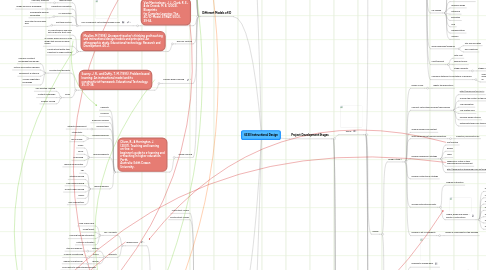
1. History of Instructional media
1.1. Impacted by socio-cultural, political, technological shifts/changes
1.2. School museums (1900s)
1.2.1. Visual materials
1.2.2. shift in focus from teacher
1.3. Visual Instruction Movement/Instructional films (pre WW1 to Mid 1920s)
1.3.1. Magic lanters
1.3.2. Steropticons
1.3.3. Projectors
1.4. Audiovisual Instruction Movement and Instructional Radio (1920s/1930s)
1.4.1. Radio
1.4.2. Sound in movies
1.5. WW2 (Late 1930s to mid 1940s)
1.5.1. Impact on schools
1.5.2. Military training films and equipment
1.6. Post WW2 and media research
1.6.1. Comparison studies
1.6.2. Communication theories
1.6.3. Instructional TV
1.6.4. Shifting terminology
1.6.5. New technology Computers
1.7. Recent developments
1.7.1. CDRom
1.7.2. WWW
1.7.2.1. Low cost
1.7.2.2. Ease of access
1.7.2.3. Increased interactivity
1.7.2.4. Higher Ed and military use
1.7.3. Intranets
2. Different Models of ID
2.1. Linear
2.2. Spiral
2.3. Oval
2.4. Rapid Prototype
2.5. Learning by Doing
2.5.1. Case Based Reasoning
2.5.2. Kolb's Learning Cycle
2.5.3. Resource Based Learning
2.5.4. Dufour's Model
2.5.5. Jonassen, D. (1999). Designing constructivist learning environments. In C. M. Reigeluth (Ed.), Instructional Design Theories and Models: A New Paradigm of Instructional Theory, volume 2 (pp. 215—239). Hillsdale, NJ: Lawrence Erlbaum Associates.
2.5.5.1. Logical Problems
2.5.5.2. Algorithms
2.5.5.3. Story Problems
2.5.5.4. Rule using problems
2.5.5.5. Decision making problems
2.5.5.6. Troubleshooting problems
2.5.5.7. situated sace-policy problems
2.5.5.8. Design problems
2.5.5.9. Dilemma
2.5.6. RASE Model
2.5.6.1. Resources
2.5.6.2. Activity
2.5.6.3. Support
2.5.6.4. Evaluation
2.6. Van Merrienboer, J. J., Clark, R. E., & de Croock, M. B. (2002). Blueprints for Complex Learning: The 4C/ID-Model. ETR&D, 50(2), 39-64.
2.6.1. Four Component Instructional Design Model
2.6.1.1. Learning Tasks
2.6.1.1.1. Concrete, authentic
2.6.1.2. Supportive Information
2.6.1.2.1. Bridge from prior knowledge
2.6.1.3. JIT Information
2.6.1.3.1. Prerequesite learning information
2.6.1.4. Part-task Practice
2.6.1.4.1. Small step to build larger skills
2.7. 'Real life' Factrors
2.7.1. Moallen, M (1998). An expert teacher's thinking and teaching and instructional design models and principles: An ethnographic study. Educational technology, Research and Development. 46, 2.
2.7.1.1. ID is spontaneous and does not conform to strict rules
2.7.1.2. ID Models should focus on fluid design that evolves as needs require
2.7.1.3. Construstivist better than cognitivist in school setting.
2.8. Problem Based Learning
2.8.1. Savery, J. R., and Duffy, T. M. (1995). Problem based learning: An instructional model and its constructivist framework. Educational Technology, 35, 31-38.
2.8.1.1. Constructivist Elements
2.8.1.1.1. Learners construct knowledge through PBL
2.8.1.1.2. Critical and Creative Thinking
2.8.1.1.3. Puzzlement as stimulus
2.8.1.1.4. Socially negotiated knowledge
2.8.1.2. Goals
2.8.1.2.1. Self-Directed Learning
2.8.1.2.2. Content Knowledge
2.8.1.2.3. Problem Solving
2.9. Online Learning
2.9.1. Oliver, R., & Herrington, J. (2001). Teaching and learning on-line: a beginner’s guide to e-learning and e-teaching in higher education. Perth, Australia: Edith Cowan University.
2.9.1.1. Flexibility
2.9.1.2. Ecomony
2.9.1.3. Enhanced Learning
2.9.1.4. Learning tasks
2.9.1.4.1. authentic assessment
2.9.1.5. Learning resources
2.9.1.5.1. Interactivity
2.9.1.5.2. Use of media
2.9.1.6. Learning supports
2.9.1.6.1. Online
2.9.1.6.2. Social
2.9.1.6.3. Scaffolding
2.9.1.6.4. Learning communities
2.9.1.7. Learning designs
2.9.1.7.1. PBL
2.9.1.7.2. Situated learning
2.9.1.7.3. Case-based learning
2.9.1.7.4. Project based learning
2.9.1.7.5. Inquiry
2.9.1.7.6. Role-playing/sims
3. Project Development Stages
3.1. ADDIE
3.1.1. Analysis
3.1.1.1. Considerations
3.1.1.1.1. Needs Analysis
3.1.1.1.2. User/Audience Analysis
3.1.1.1.3. System/technology Analysis
3.1.1.1.4. Content
3.1.1.1.5. Feasability
3.1.1.1.6. Risk
3.1.1.1.7. Other Considerations
3.1.1.2. Project Proposal
3.1.1.2.1. Gives Clients enough info to green light project
3.1.1.2.2. Elements
3.1.2. Design
3.1.2.1. Design: Stage 1
3.1.2.1.1. Define a Goal
3.1.2.1.2. Conduct Instructional Analysis/Task analysis
3.1.2.1.3. Analyse learners and context
3.1.2.1.4. Write performance/Learning Objectives
3.1.2.1.5. Develop assessment strategy
3.1.2.1.6. Develop Instructional Strategy
3.1.2.1.7. Arrange Instructional Events
3.1.2.1.8. Develop a set of flowcharts
3.1.2.2. Design Stage 2
3.1.2.2.1. Flowcharts arrange ideas
3.1.2.2.2. Storyboard show how those ideas will appear
3.1.3. Development
3.1.3.1. Prototype
3.1.3.1.1. Working Model
3.1.3.1.2. Representation of final project
3.1.3.1.3. Provides information to allow client and team to see basic format of the final product
3.1.3.1.4. Important Evolution tool
3.1.3.1.5. Types of products designed
3.1.3.1.6. Multimedia Learning Theory
3.1.3.1.7. Interface Design
3.1.3.1.8. Interaction Design
3.1.3.1.9. PresentationDesign
3.1.3.1.10. Prototype Evaluation
3.1.3.1.11. Design
3.1.4. Implementation
3.1.4.1. Delivery
3.1.5. Evaluation
3.1.5.1. Summative
3.1.5.1.1. Kirkpatrick, D. L. (1994). Evaluating Training Programs. San Francisco: Berrett-Koehler Publishers, Inc.
3.2. http://www.nwlink.com/~donclark/hrd/sat2.html
3.3. Different approaches/flows to achieve.
3.4. Project team roles
3.4.1. Depends on scale of project
3.4.2. Work insourced and outsourced
3.4.3. ID is central to project
4. Learning Theories
4.1. Instructivist Models
4.2. Constructivist Models
4.3. Mergel, B (1998). Instructional design & learning theories.
4.3.1. Behaviourism
4.3.1.1. Key concepts
4.3.1.1.1. Mind as black box
4.3.1.1.2. Cause/effect
4.3.1.1.3. Learning through interaction
4.3.1.1.4. Extrinsic motiviation
4.3.1.2. Theorists
4.3.1.2.1. Watson
4.3.1.2.2. Pavlov
4.3.1.2.3. Skinner
4.3.2. Cognitivism
4.3.2.1. Key Concepts
4.3.2.1.1. Mind central to understanding learning
4.3.2.1.2. Internal information processing
4.3.2.1.3. mental models
4.3.2.1.4. Thinking involves manipulation of representations
4.3.2.1.5. Rules, patterns strategies, chunking
4.3.2.2. Theorists
4.3.2.2.1. Piaget
4.3.3. Constructivism
4.3.3.1. Key Concepts
4.3.3.1.1. Subjective mental representations
4.3.3.1.2. Knowledge constructed through assimilation and accommodation of new information
4.3.3.1.3. Social negotiation of knowledge
4.3.3.1.4. contextual learning
4.3.3.2. Theorists
4.3.3.2.1. Congitive Constructivists
4.3.3.2.2. Social Constructivists
5. Instructional Designing
5.1. Instructional Design vs Lesson Planning
5.1.1. Broader, tends to manage project of learning design, rather than deliver it.
5.1.2. Sometimes ID will not even know who will teach/deliver learning
5.2. ID in different Environments
5.2.1. Case Studies
5.2.1.1. Range of studies that looked at the process, problems and dynamics of ID in educational and commercial settings. Large and small scale projects explored.
5.2.2. Educational & Commercial
5.2.2.1. Context for Development
5.2.2.1.1. Outsourcing
5.2.2.1.2. In House
5.2.2.1.3. Buy existing
5.3. History
5.3.1. Reiser, R. A. (2001). A history of instructional design and technology: Part I: A history of instructional media. ETR&D, 49(1), 53-64.
5.3.1.1. History of instructional Design
5.3.1.1.1. Origins
5.3.1.1.2. 1950s to 1960s developments
5.3.1.1.3. Early ID models
